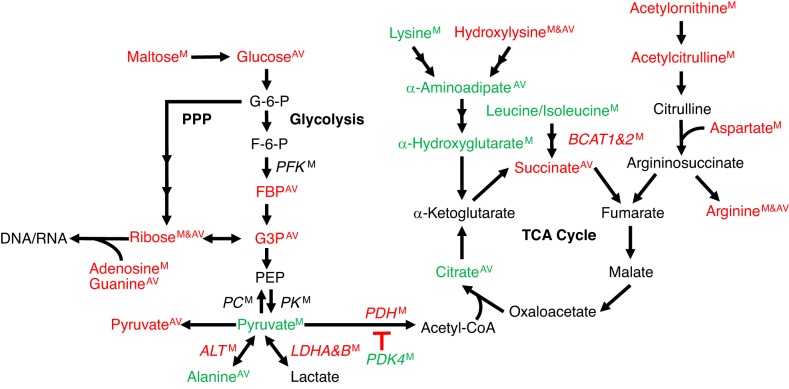Fig. 6.
Pathway diagram of glycolysis, pentose phosphate pathway (PPP), and tricarboxylic acid (TCA) cycle highlighting metabolites that differed between control (CON) and intrauterine growth restriction (IUGR) fetal skeletal muscle and plasma. Selected metabolites are shown from the top 30 variable importance in projection scores that were higher (green), lower (red), or unchanged (black) in IUGR (n = 10) fetal skeletal muscle (M) and/or femoral arterial and venous plasma (AV) when compared with CON (n = 8) fetuses. The gene expression of selected enzymes (italics) in the fetal skeletal muscle also are shown. PPP production of ribose was lower in IUGR muscle and AV, as was adenosine in IUGR muscle for DNA/RNA and ATP production. Despite lower glycolytic intermediates in IUGR AV, pyruvate concentrations were higher in IUGR muscle. LDHA, LDHB, and PDH expressions was lower in IUGR muscle, and alanine concentrations were higher in IUGR AV, supporting alanine release from muscle, as opposed to lactate production or conversion of pyruvate to acetyl-CoA for entry into the TCA cycle. Lysine and its catabolic product α-hydroxyglutarate were higher in IUGR muscle, yet α-ketoglutarate concentrations were unchanged; leucine/isoleucine concentrations also were higher in IUGR muscle, yet BCAT expression was lower, further supporting limited substrate entry into the TCA cycle in IUGR muscle. Finally, intermediates in the arginine synthesis pathway were lower in IUGR muscle. ALT, alanine aminotransaminase 1; BCAT1, branched-chain amino acid transaminase 1; BCAT2, branched-chain amino acid transaminase 2; FBP, fructose 1,6-bisphosphate; G3P, sn-glycerol 3-phosphate; LDHA, lactate dehydrogenase A; LDHB, lactate dehydrogenase B; PC, pyruvate carboxylase; PDH, pyruvate dehydrogenase; PDK4, pyruvate dehydrogenase kinase 4; PFK, phosphofructokinase; PK, pyruvate kinase.

